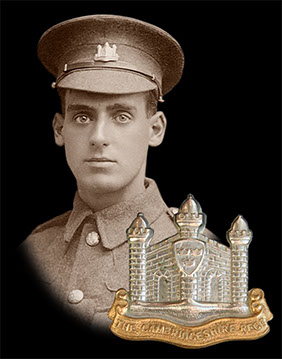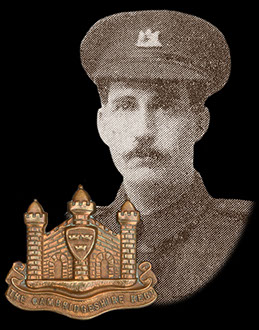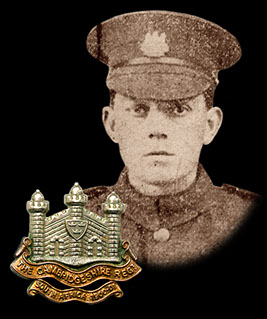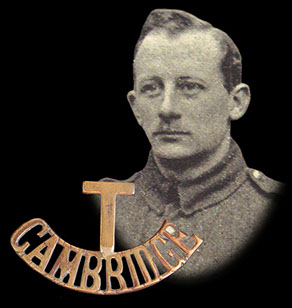
Who Were
The Cambs
The Cambs
at War
1/1st Btn 1914-1919
1914 - 1/1st Overview
1915 - 1/1st Overview
1915 - St Eloi
1915 - Fosse Wood
1916 - 1/1st Overview
1916 - The Schwaben
1916 - St Pierre Divion
1917 - 1/1st Overview
1917 - St Julien
Insignia, Medals & Books
Remembering The Cambs
Biographies
About Us &
This Site
Aftermath of Battle - August 1917
The opening day of the Third Battle of Ypres on July 31st 1917 may have been over, but the battered remnants of the 1/1st Cambridgeshires would hang on in the old German front line until late on August 1st.
One wounded soldier wrote home about the mixed emotions of getting out of the line. I left the field downhearted upon seeing so many of my Cambs chums lying with their faces to the ground, having made the last great sacrifice, said L/Cpl Bernard Barker, of Chatteris, who was in C Company and had been wounded, reaching a hospital in Cardiff on August 9th.
When the shattered men of the Cambs Regt gathered in the afternoon of August 1st, they were reorganised into two small companies. There was to be no relief for the following day as it was expected that the Germans would counter attack, and the battered battalion, about 200 men and four remaining officers, moved into a support position in the old German front line. That evening they moved up to the area near Mouse Trap Farm, where the whole area was almost a foot deep in mud. On August 4th, the battalion moved into the front line near the Steenbeck stream and Alberta, but were finally relieved and out of the line on August 5th.
For days after the original attack, wounded men were being recovered from the battlefield, with some unable to leave the shelter of former German pillboxes and strongpoints. One such man was Pte Cyril Chapman, of Walpole St Andrew, who was found by the Germans on August 6th. He wrote from captivity about his experiences of being wounded on July 31st and getting into German concrete dugout with some others from the Cambs Regt.
We were there for six days until we were found, and while in the dugout lived on German tinned meat, with bottles of soda water to drink, but on August 5th we finished the food,” he said.
Trying to reach the British lines was impossible. “To appear at the doorway was certain death, for an enemy sniper kept sending a few bullets in it – one was sniped while coming in the dugout, and another died inside the second night. There were three unwounded men, and that made us 12 Englishmen and one German, said Chapman.
On the morning of the 6th we were in a poor state and were greatly relieved when we saw more Fritz come in the doorway. They were as much surprised to find us in there, and rushed for the doorway, but came back to fetch us with waterproofs slung on long poles. We were carried to an old gun position, where we were given some food, drink and cigarettes, but we noticed these were English, and taken from our packs which lay on the battlefield. Most of us had broken legs or very serious wounds, and they were dressed and our legs put in splints, then we were carried further behind the line, later being sent to different hospitals, said Chapman.
It is believed among the other men captured with Chapman, were others from C Company, including Ptes Wallace Foulger, Tom Burgess, Abraham Peters, Jack Gowler and William Norman, and Pte Ernest Whiteman (A Coy).
Cyril Chapman’s brother Oliver had been wounded on July 31st while carrying a message from battalion HQ to his company commander, Capt Jonas (who would not survive the battle). Oliver, who was accompanied by a comrade, wrote home:
While we were running with the message, my mate got shot through the leg by a sniper, and I took the message from him and carried on with it to my company officer. I was sniped several times whilst I was running, and one just managed to get me through the muscle part of the arm as I was handing the message to the Captain, he added. Afterwards he managed to walk to the dressing station, and, eventually, was sent to England.
Like many of the wounded, Oliver would have passed through the dressing station to a Field Ambulance and back to a base hospital on the French coast. In the days and weeks that followed the attack on July 31st, some of the injured succumbed to their wounds.
One of them was Sgt Herbert English, of March, serving in D Company, who died of wounds on August 6th. His colleague Sgt Herbert Sheldrick, who was awarded the MM for his work on July 31st, wrote: Everything went well until the afternoon when we were held up and the shellfire became so heavy that we were forced to take cover in the huge craters and shell holes. Our company was rather in advance of the rest and consequently we were having a very hot time.
We held our position until about 4pm, we were ordered to withdraw slowly to a stronger line of defence. Just at this time a whizz-bang fell in the shell hole where your son and his platoon had taken cover, wounding all of them.
The hero of the action at Border House, Pte W H ‘Sam’ Muffett, would recall in 1958 when aged 60, that Sgt English, who was aged 22, was among the men holding off the Germans. Another had been Pte Len Brown, from Wisbech, who would be drowned in a bathing accident on August 22nd.
Others who were to die of wounds received on July 31st included Pte Walter Stanford, of Chesterton, Pte Arthur Carder and Pte Arthur Page, both of Ickelton, Pte John Taylor, of Littleport, Pte Ernest Battley, of Saxmundham, and finally CSM Herbert Chapman, a pre-war Territorial from Trumpington, who was a compositor at the Cambridge University Press, and who suffered a throat and mouth wound. He lingered until September 4th.
Having spent a week out of the line in order to reorganize, the battalion moved into the area near Ridge Wood on August 15th, before the 118th Brigade relieved the 117th Brigade in the Klein Zillebeke sector.
As their commanding officer, Lt-Col ‘Ted’ Riddell stated: The great battle which had begun on 31 July continued to rage along the whole front of the Ypres salient. Fresh divisions went ‘over the top’, fell back to rest, received drafts of recruits or patched up old soldiers, returned to the line, and then they went ‘over the top’ again.
The Klein Zillebeke area was like much of the Ypres Salient - a mess of collapsed trenches and shell holes
Riddell wrote: There were no trenches here, only a maze of shell-holes converted into little forts. Each of these miniature strongholds gave inadequate cover to a corporal and five men. The garrison crouched on the ground by day, for it was a suicidal act to show your head. As dusk was changing into night the relieving sections crept out for their twenty-four hours of duty.
Four men were wounded when a gas shell hit their dugout on August 20th.Three days later the Cambs Rgt relieved their colleagues, the Hertfordshires, in the front line at Klein Zillebeke. The relief was completed by 1am on August 24th, and the same day men of B Coy captured two Germans with a bag of mail, which provided useful intelligence for the British about German morale. Two more men were wounded that day, while German artillery on August 26th wounded a further five men. During the relief of the Cambs Regt on August 27/28th, a man was killed and another wounded.
During August, 200 reinforcements had arrived with the Battalion from various sources and more would arrive from England in September. As Lt-Col Riddell was to observe, the Cambridgeshires’ turn to attack would come again on September 26th.

Bernard Barker from Chatteris.

Arthur Carder of Ickleton, died of wounds.

Walter Stanford, died of wounds he received at St Julien.

CSM Herbert Chapman, a pre-war Pitt Press worker, died of wounds September 4th.

This site went live on the 14th February 2015 to mark 100 years since the 1/1st Cambs went off to war.
WE WILL REMEMBER THEM
Email us: cambsregt@gmail.com
Copyright 2015, 2016, 2017, 2018, 2019 by Felix Jackson. The information and images on this site should not be reproduced without prior permission.